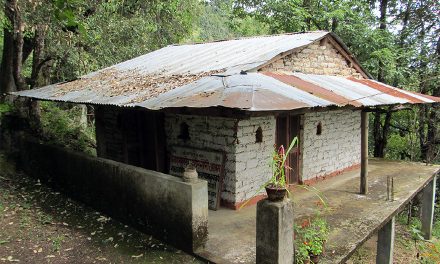The sacred shrine of Gangotri dham is the first of the four Char Dhams to be visited on pilgrimage. Located 99 kilometres form Uttarkashi, it is situated at an altitude of 10,500 ft. and marks the source of the River Bhagirathi. The site is surrounded by mountain peaks known as Shivlinga, Satopanth and the Bhagirathi sisters.
According to sastra, the heavenly Goddess Ganga manifested herself in the form of a river to absolve the sins of King Sagar’s sons. After three generations of severe penance, performed over hundreds of years, Ganga Ma conceded to descend to the Earth. Here, at the sacred source of the river, Goddess Ganga is worshipped in her Deity form.
The persistence and austerities performed by King Bhagirath, who was the great-great-grandson of King Sagar, play a central role in the manifestation of the Ganga here. King Sagar had 60,000 sons who were burned to ash by the sage Kapila after they had erroneously accused him of being a thief. Kapila later advised Amshuman, King Sagar’s grandson, that only by bringing the Ganges down from the heavens could peace be properly restored.
Amshuman and his son Dilip both tried unsuccessfully to follow Kapila’s instructions. Dilip’s son, Bhagirath, eventually retired to Gangotri to perform great austerities finally the demigods agreed to send Ganga to earth. Next Bhagirath appealed to Lord Shiva to allow Ganga Ma, in the form of the Ganges waters, fall on his head, since its force would otherwise destroy the earth planet. Once Ganga touched earth, Bhagirath led her out of the mountains and to the sea, where she touched his ancestors’ ashes and finally washed away the sinful reactions.
In its journey to the sea, the Ganges River travels some 2,500 kms across the Indian subcontinent, blessing the people of India and Bangladesh with life-giving water. The Sunderban delta in Bangladesh is now the world’s largest and most fertile delta.
While Gangotri is the place of worship associated with the source of the Ganges, the actual source is understood to be the glacier at Gaumukh, which is 12 miles upstream.
The current temple dedicated to Ganga Ma was built about 250 years ago by the Gurkha monarch, Amar Singh Thapa. The structure was then restored in the late 19th century. The temple is open for pilgrims from October to May. During the winter months, when the area is covered by deep snow, Ganga Ma retreats to Mukhba, 12 kilometres downstream, where she is worshipped.
The main temple complex at Gangotri is made of white granite and is twenty feet tall. Close to the temple is a stone known to be the Bhaigirath shila, which marks the place where Bhagiratha meditated and did penance to encourage Mother Ganga to earth.
At Gangotri temple, a railing is placed across the sanctum to prevent entrance into the main temple area. Each morning and evening, the Ganga Ma’s Deity is brought out to give darshan to all the pilgrims.
Up until 1987, pilgrimage had to cross a dangerously swaying rope that enabled them to cross the Ganga’s raging torrents, and get to the dhamagrounds. Many lost their lives to the water here. Eventually a bridge was put in place, making it easier and safer to cross.
Near the Gangotri temple is a smaller temple dedicated to Lord Shiva. Built in the Nagara architectural style, it has a high tower prominently featured overtop the Deity. Also submerged in the waters by the temple is a Shivling that is visible in early winter, when the water level is lowest. Devotees understand this to represent the place where Ganga flowed into Shiva’s hair.
Pilgrims traveling to Gangotri char-dhama also visit holy sites around the base of the glacier. Harsil, Vasuki tal, Sattal, and Nandanvan are nearby. In Uttarkashi, 99 kms. from Gangotri, are found the Vishwanath temple, Ekadash Rudra temple, Gyaneshwar temple and Kuteti Devi temple. Dayayra Bugyal, about 93 kilometres from Gangotri, is the home of a famous Sheshnaga temple.












